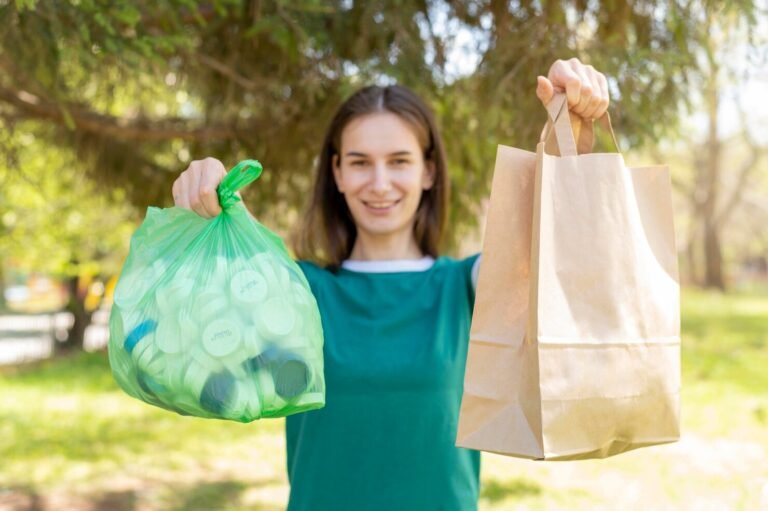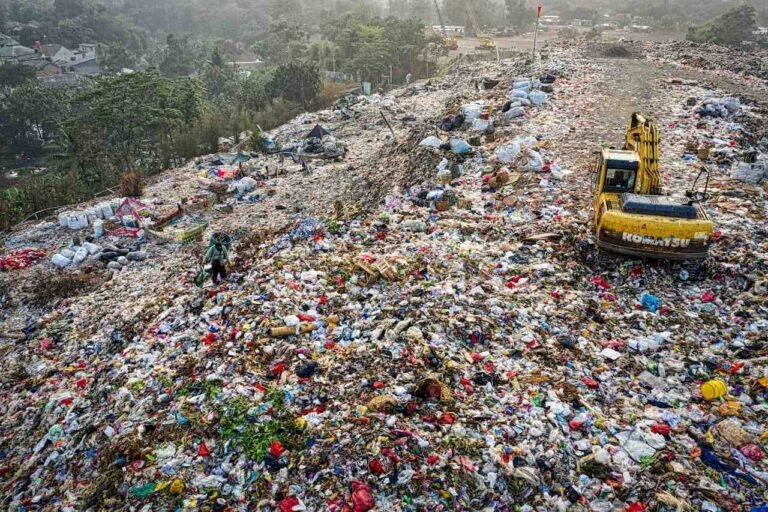Can Plastic Roads Fix Plastic Pollution?
The idea is deliciously simple: take the plastic people throw away, melt or reprocess it, and lock it into roads so it never becomes litter or ocean waste. The image of streets built from yesterday’s sachets and coffee cups is appealing — and there are real projects that make it sound plausible. In Zwolle, the Netherlands, a 30-metre bike path built from recycled plastic has been monitored for years as a proof of concept. A number of companies and city pilots — from India’s early experiments to recent U.S. test sections — claim benefits such as longer life, fewer potholes and lower material costs.
But the real question for policy makers, engineers and communities is not whether you can make a road out of plastic, but whether doing so meaningfully reduces plastic pollution — without trading it for other harms. That balance is where the research, field pilots, and international reviews converge: plastic roads can divert some unrecyclable waste from landfills and dumps, and in places, they may make practical sense, but they are not a silver-bullet fix for the global plastic crisis.
A 2023 report by the World Bank argued that the approach “can prevent a significant portion of unrecyclable plastic waste from becoming a large-scale pollutant,” while also warning that key environmental unknowns remain and rigorous monitoring is required.

In This Article
- What Pilots and Numbers Tell Us
- What Scientists and Communities Warn About
- Where this Leaves Cities, Engineers and Citizens — Practical Advice
- Conclusion — a clear, short verdict
What Pilots and Numbers Tell Us
Real roads already exist. India has been a global leader in deploying plastic-modified bitumen for decades; the government reported that, as of July 2021, 703 kilometres of national highways had used waste plastic in the wearing course. Those projects grew from grassroots practice and a simple technique developed by Professor R. Vasudevan that adds shredded plastics into hot-mix aggregate. India’s experience shows plastic mixtures can be scaled quickly where regulation, materials recovery and labour align.
Other pilots are testing different models. A report by The Guardian suggests that the PlasticRoad concept in the Netherlands uses prefabricated hollow modules made largely from recycled plastics. The Zwolle bike path drew attention because it included sensors and was designed to be lighter, recyclable, and capable of housing cables or drainage. In the U.S., city and national test tracks have laid small sections with proprietary recycled-plastic additives (for example, MacRebur products or LLDPE-rich pellets) to measure durability and emissions. The National Academies’ summary of recent work notes multiple field experiments on both test tracks and public streets and emphasises that long-term monitoring is still needed to understand performance and environmental impacts.
Numbers are striking. Engineers and reviewers often use a rough benchmark of about one tonne of mixed plastic per kilometre of road, though actual rates vary by method and mix. The World Bank has pointed out that, if properly targeted, using plastic in roads could divert meaningful quantities of otherwise hard-to-recycle waste. Still, the scale is modest compared with global plastic production, and feasibility depends on local waste streams and road-building needs. One World Bank report even described plastic roads as “one practical sink” for certain plastics — but not a silver-bullet solution to the mountains of plastic the world continues to generate.
What Scientists and Communities Warn About
Engineers and environmental scientists give a mixed verdict. Laboratory and early field work consistently show that adding certain polyolefins (PE, PP) can improve high-temperature rutting resistance and sometimes increase service life. But the environmental and health questions are active and serious. A comprehensive review published in 2025 summarised the evidence: while performance benefits exist, there are clear pathways for harm, including toxic emissions during high-temperature mixing, potential leaching of additives and heavy metals, and the generation of microplastics from wear and weathering over time. The paper calls for careful trade-off analysis and monitoring for air, soil and water impacts at every stage — from processing to eventual road wear.
Very recent field science confirms a practical worry: pavement itself is a source of microplastics. A two-year field and lab study found that pavement wear contributes microplastic particles to stormwater, separate from tire wear, and that the amount depends on pavement type and condition. That matters because if plastics are intentionally added to road materials, we must ask whether those plastics (or their additives) will later enter storm drains, rivers and soils as small particles that are harder to capture and clean. In short: a plastic road that sheds microplastics could swap visible litter for invisible pollution.
Community experiences add a practical perspective. In Meghalaya, India, The Indian Express reported that villagers banded together to collect a few hundred kilograms of local plastic waste and help build a one-kilometre stretch of road — a real local win that improved a dirt track and drew attention to reuse options. However, community leaders also note that collection, cleaning, and shredding require sustained organisation. Without that, so-called “plastic roads” can simply become another place where poorly sorted or contaminated plastics are burned, melted improperly, or mixed unsafely. Professor Vasudevan, who pioneered the simple plastic-bitumen method, has repeatedly emphasised that plastic in roads only works when paired with proper waste collection, worker safety, and clear technical standards.

Where this Leaves Cities, Engineers and Citizens — Practical Advice
A careful, evidence-led approach is the only responsible way forward. Based on current pilots, reviews and peer-reviewed research, here are practical, immediate recommendations for anyone considering plastic roads, written for officials, engineers and informed citizens.
First, be explicit about the goal. If the aim is to divert non-recyclable plastics locally and to extend pavement life in a place with limited resources, pilots may make sense. A project coupled to a study that measures air emissions during mixing, tests stormwater runoff for microplastics and plans for end-of-life recycling is not optional — it’s essential. The World Bank 2023 report urged exactly this kind of concurrent monitoring alongside pilots.
Second, pick the right plastics and the right process. Reviews and laboratory work show that polyolefins (PE, PP) behave differently from PVC or polystyrene; some plastics release more hazardous compounds at high temperatures. Experts recommend limiting inclusion to well-characterised plastics and using compatibilisers when required, and they stress testing mixes under local climate and traffic conditions before any large rollout.
Third, protect workers and neighbours. High-temperature mixing can emit PAHs and VOCs; engineering controls, fume capture and personal protective equipment must be in place for plants and pave crews. The comprehensive review in 2025 flagged occupational exposure as a clear risk during production that needs regulation and monitoring.
Fourth, measure microplastics and runoff from day one. Pavement wear has already been shown to produce microplastics in stormwater; projects that add plastic to pavements should include baseline and ongoing sampling of runoff, roadside soils and air particulates. That data will tell whether a project is trading visible plastic litter for dispersed microplastic contamination. Recent field studies make that trade-off measurable for the first time.
Fifth, keep the circularity question front and centre. Conventional asphalt can be reclaimed and reused at end-of-life; the long-term recyclability of mixed plastic-asphalt composites is not yet demonstrated at scale. The National Academies warned that disrupting the circularity of pavement would be a “game-ending consequence” for the environmental case — so build exit strategies: can the mix be reclaimed, separated and safely processed, or will it consign materials to landfill?
Sixth, use plastic roads as one tool, not a solution. Even optimistic World Bank estimates and pilots show scale limits: plastic-in-roads will never absorb the bulk of global plastic production. The higher payoff comes from upstream measures (reduce single-use plastics, redesign packaging, increase reuse and efficient recycling) combined with targeted downstream sinks — including roads — only where they demonstrably lower environmental burden.
A short statistics snapshot (case study table)
| Case or finding | Key number or result |
|---|---|
| India national highways with plastic wearing course (reported) | 703 km (to July 2021) |
| World Bank recommendation | Report (2023): approach may divert unrecyclable plastics, but needs rigorous monitoring |
| Microplastics from pavement wear | Field study shows pavement wear is a direct source of microplastics in stormwater (2024–25 study) |
| Comprehensive environmental review | 2025 review: benefits (durability) vs risks (toxic emissions, microplastics) — monitoring needed |
| National R&D & test tracks | NCAT / MnROAD / NYC trials underway; long-term results pending |
Conclusion — a clear, short verdict
Plastic roads are a promising, pragmatic use for some hard-to-recycle plastics when projects are designed responsibly, accompanied by independent monitoring, and integrated into broader waste-management reforms. They are not a magic bullet. The best outcomes come when plastic road pilots: target unrecyclable local waste streams; use carefully chosen plastics and mix designs; require worker and environmental safeguards; measure microplastic release and emissions; and build an exit and recycling plan for end-of-life. As the World Bank put it in 2023, the technology can “prevent a significant portion of unrecyclable plastic waste” — but only if we fill the current knowledge gaps with science and public oversight, not just hope.







